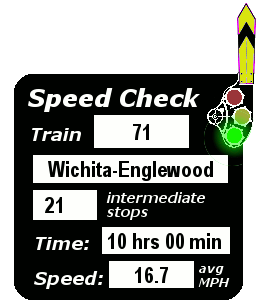



Time:
A - A.M.
D - Train stops only to discharge passengers
F - Conditional (Flag) stop
I - Customs/Immigration inspection stop
M - Meal stop
N - Not a passenger stop
P - P.M.
R - Train stops only to receive passengers
Services:
A - Auto loading/unloading facilities (as freight)
B - Checked baggage is handled
C - Coupon station (Ticket office)
I - International border inspection station
M - Food service available
P - Telephone station
R - Rental cars available
T - Telegraph station
X - Checked baggage NOT handled





When Walter Lee Simms hired on with the Santa Fe railway in the late 1960s, the local depot agent was still one of the best-known (and highest paid) citizens of many a small Kansas town. Old-fashioned Morse Code telegraphy was (in many locations) still the only method for transmission of official railroad business and Western Union telegrams, and some of the names on the seniority roster had been there since World War I (and even before!).
In the wake of the Post Office decision to yank the mail from the rails in 1967 and Santa Fe President John S. Reed's subsequent "Eulogy to the Chiefs" the local branch line passenger train was officially an endangered species, but it was not dead yet. True, Walter states that during his time as an agent in the Kansas branch-line territory he only sold a ticket to one living passenger—a Hispanic gentleman who elected to ride into Wichita on a semi-regular basis to cash his Social Security checks—but note the caveat, "living". The rails were still frequently used for transport of human remains, and Walter remembers several calls to the local funeral homes to inform them that a new customer had just arrived. The Railway Express Agency (by then known as R E A Express) was still a going concern and the LCL (Less than Car Load...small shipments) freight business was still significant. The branch-line mixed local handled all of this.
The branch-line local, as Walter remembers it, was a string of freight cars with an old heavyweight coach-baggage combine bringing up the markers at the tail end. One day while he was a trainee in Ashland the senior station agent suggested that he hop the local and ride it out to Englewood and back, which he eagerly did. The train crew invited him to leave the passenger seating area and join them in the airy baggage compartment, where they rode in comfortable chairs with the sliding door open. There was another feature in that baggage compartment: A large galvanized ice chest, probably intended for the express shipment of perishables. With no perishables on the manifest that day, the train crew had put that ice chest to good use: It was well stocked with soda, fruit juices...and Everclear.
By the time the mixed local returned to Ashland Walter and his train crew were a mite sloshed. Fortunately for them, today's stringent drug and alcohol testing was still years in the future.